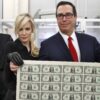Introduction
Subscribe on Spotify | Google | Stitcher | TuneIn | Pandora | Apple Podcasts
Episode 3 of The Heist
Congressional Republicans and the Trump administration spent most of 2017 claiming the Tax Cuts and Jobs Act would not add to the nation’s debt. It might even go down, they said.
But almost every legitimate analysis of the bill — including one by Richard Prisinzano, who had worked in the Treasury Department’s Office of Tax Analysis — showed it would add to the debt.
Prisinzano, a self-proclaimed “numbers guy,” had been a tax analyst for 13 years, working in the administrations of George W. Bush, Barack Obama and Donald Trump. He left the Treasury in the summer of 2017, a couple of months before the tax bill was introduced in Congress. He joined the Penn Wharton Budget Model at the University of Pennsylvania, which analyzes the fiscal impact of public policy, where he does similar work as he’d done at Treasury.
The Trump administration had been selling the bill as revenue-neutral.
But when Prisinzano ran the numbers at his new job, and his former colleagues analyzed the bill at Treasury, they reached similar conclusions: The bill would add about $1.5 trillion to the nation’s debt.
Instead of figuring out how to tackle that problem, congressional Republicans and the Trump administration simply moved the goalposts.
“They changed from ‘revenue-neutral’ to ‘it will pay for itself,’ which is a slightly different concept,” Prisinzano said.
The new idea was that the bill would cut taxes so much that businesses would reinvest, causing the economy to grow and generating more tax revenue. The tax cuts would pay for themselves. But Treasury Secretary Steven Mnuchin made a bolder promise.
“Not only will this tax bill pay for itself, but it will pay down debt,” Mnuchin said at the Washington Ideas forum in 2017.
Both Democrats and Republicans agreed prior to the bill’s introduction that tax reform was needed. Obama talked about lowering the corporate tax rate so that American companies wouldn’t take business overseas, where tax rates were lower.
But of all the economists who analyzed the Tax Cuts and Jobs Act, only the Council of Economic Advisers — embedded within the executive office of the president — said the legislation would pay for itself. That was the analysis Mnuchin decided to go with.
“It’s really frustrating to see someone ignore what I would call a consensus across a discipline,” Prisinzano said.
Convincing Corker
But the Trump administration still needed Congress to authorize taking on that debt before it could move the tax bill forward.
Enter Bob Corker, a Republican senator from Tennessee. Corker grew up in Chattanooga. He had been senior class president in high school, voted “best all-around boy” in his yearbook. In college, his frat brothers said he was the kind of guy who loved a good party, but never got super drunk. He started his own construction company, became mayor of Chattanooga, then was elected senator.
During his 12-year Senate career, Corker was one of the few moderates on the GOP side of the aisle. He also was one of the chamber’s biggest deficit hawks. He called the federal debt America’s biggest national security threat, bigger even than North Korea. Corker was skeptical of the tax bill.
“We’ve got to figure out a way to not just do the sugar side of this, but to do the spinach side,” he said at a hearing of the Senate Banking, Housing, and Urban Affairs Committee in May 2017. “And I’m just going to tell you right now I see no evidence whatsoever, no evidence, of us being willing to deal with the spinach side of the equation. So, I think we’re in a hell of a mess right now — a hell of a mess.”
Republicans needed Corker’s vote to authorize more than a trillion dollars of debt the tax cuts would create. That permission came from the Budget Committee, where Corker was one of 11 Republicans. Ten Democrats also sat on the committee. If Corker didn’t agree to taking on the additional debt, the bill could die there. Majority Leader Mitch McConnell, a Republican from Kentucky, could move the bill forward by relying on arcane rules. But that would open up unwanted opposition to the tax bill.
McConnell had other plans. In September 2017, he called a meeting between Corker and Sen. Pat Toomey, a Republican from Pennsylvania who also was a member of the Budget Committee. Toomey wanted to take on even more debt — as much as $2.5 trillion — to cut taxes deeper. They met in McConnell’s office, which has a view of the Washington Monument.
Only those who were in the room know what happened there. McConnell, Toomey and Corker declined to be interviewed. But the result of the 10-minute meeting is known: Corker, the man who’d sworn never to vote for a bill that would add a penny to the debt, agreed to increase it by $1.5 trillion.
Weeks later, when the tax bill was on the Senate floor for a vote, Corker had doubts. He introduced the idea of a so-called trigger, which would raise taxes if revenues fell more than estimated. But the Senate parliamentarian said the trigger could not be considered because it violated rules. Corker was upset. He voted no on the bill.
But by this time, McConnell no longer needed Corker. He had the votes to pass the bill.
Trickle down
If most economic reports showed the tax bill wouldn’t pay for itself, why were Mnuchin and congressional Republicans working so hard to make it look like it would? It has to do with the history around Republicans and tax reform, especially trickle-down economics. The theory holds that if taxes on businesses and the rich are lowered, they will spend more and wind up paying more taxes. The costs of the tax cuts will be covered.
Molly Michelmore, a history professor at Washington & Lee University in Lexington, Virginia, said the theory is called “the politics of joy,” because it promises a tax cut to everyone while not increasing the debt. But “it never works,” she said.
Economist Arthur Laffer is most associated with trickle-down economics and was involved in the crafting of the 2017 tax bill. He is famous for showing lawmakers back in the 1970s a graph showing how cutting taxes could lead to increased tax revenues, something that would become known as the Laffer Curve. He insists it does work.
“There are times when you can cut tax rates and lose revenue. There are times when you can cut tax rates and gain revenues. It depends upon the specific situation at hand,” Laffer said in an interview with the Center for Public Integrity.
Michelmore offered Kansas as proof of the flawed reasoning behind trickle-down. In 2012, under Republican Gov. Sam Brownback, the state drastically cut some businesses taxes. The state’s revenues cratered and services were slashed. Voters demanded that the tax cuts be repealed.
Pass something
When Trump was elected, it was the second time Prisinzano had watched an administration change at the Treasury Department. The first time — in 2008, when Obama won — Prisinzano said the election didn’t make a big difference in his work life. But when Trump took over, “the transition was a very stark one,” he said.
After Trump was inaugurated, Obama’s political appointees at the department were immediately barred from entering the building, “which wasn’t the case from Bush to Obama — there was a little bit of overlap,” Prisinzano said.
Those who departed were not immediately replaced, including in the Office of Tax Analysis. It was up to Prisinzano and his colleagues to explain to the Trump administration that the bill it had written wasn’t going to pay for itself. Mnuchin pressed them for a different answer, but the data showed what it showed.
The administration and Congress pushed ahead, nonetheless. They had to pass a tax-cuts bill by the end of the year to please donors. A former Treasury employee who requested anonymity said the administration was so desperate to pass the bill that Mnuchin and other Republicans seemed uninterested in the content.
“Suddenly there was momentum, and the only thing that was important was passing something,” the former employee said. “There was a lot less concern about what it included. … The dynamic became just getting enough Senate votes.”
At one point, the former employee said, he was handed a list of talking points about so-called Opportunity Zones — areas Treasury would later designate “economically distressed” communities in which new investments would get preferential tax treatment in the tax bill. The talking points included an estimate that investors would put $100 billion into the zones. The former employee asked where the number came from. Mnuchin, he was told.
“They just pull stuff out of their ass,” the man said of Mnuchin and other members of the administration.
Recent estimates have put the amount of investment in opportunity zones at a small fraction of what Mnuchin said they would be.
But Republicans were scrambling to get the tax bill to Trump’s desk. Joseph Stiglitz, a Nobel Prize-winning economist and professor at Columbia University, said it was like “a group of pigs feeding at the trough. It was a frenzy. They wanted to get that tax bill out as quickly as they could, with the least transparency, so there wouldn’t be outrage from ordinary citizens.”
Senate Democrats didn’t get a copy of the bill until the day they had to vote on it in early December 2017. Senator Jon Tester, a Democrat from Montana, complained the bill was almost 500 pages long. He posted a video on his Twitter account, pointing out there were handwritten notes in the margins, calling the rushed process “Washington, D.C., at its worse.”
The Senate passed its version of the tax-cuts bill, and it was reconciled with the measure the House of Representatives passed. When the final bill came up for a vote, Corker voted for it. Reports at the time said he did so because of what became known as the “Corker Kickback” — a provision added late in the process that included tax cuts benefiting some real-estate holders, possibly including Corker’s own family. He denied the rumor. Trumped signed the bill into law on Dec. 22, 2017.
Prisinzano said he did his analysis in good faith. But the Trump administration and Republicans in Congress ignored it.
He said tax reform only comes up once in a career, and this was likely his only opportunity. “For somebody who has worked on taxes his whole career, … tax code changes come up once every 30 years or so. That was my one shot,” Prisinzano said. “And I didn’t have as much of a direct impact as I would have liked,”
Buyer’s Remorse
In April 2018, the nonpartisan Congressional Budget Office released an estimate that the new tax law would add $1.8 trillion dollars to the debt, hundreds of billions of dollars more than was previously forecast. At a Senate Budget Committee hearing that month, when the new estimate was released, Corker was not happy.
“You’ve talked about the cost of this tax bill,” Corker said at the hearing. “And if it ends up costing what has been laid out here, it could well be one of the worst votes I’ve made.”
The Treasury Department said in a statement sent to Public Integrity that the 2017 tax law benefited American families, lower-income Americans and small businesses. It did provide tax relief to middle-income wage earners, especially because of an increase in the child tax credit, said Mark Mazur, director of the nonpartisan Urban-Brookings Tax Policy Center in Washington and former head of tax policy at the Treasury Department in the Obama administration. But the $1.5 trillion in debt with which it saddled the government would have been better spent on roads, education or health care, he said.
“There’s probably no shortage of things you could have invested in that have a higher rate of return than what we’re going to get from the Tax Cuts and Jobs Act,” Mazur said. Instead, corporations were handed the biggest tax cut in history. And wealthy donors got what they wanted.





Join the conversation
Show Comments